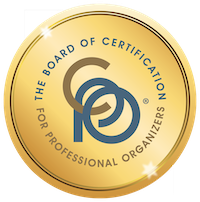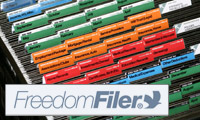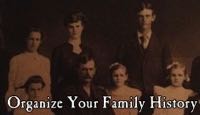Happiness is a new kitchen
This is the first of three posts on our recent kitchen renovation. You can also read the lessons learned from our kitchen renovation and the favorite storage features of my new kitchen. This kitchen renovation has very successful for us and I wanted to share!
After only 24 years of living with an 80s-era kitchen in our 1908 home, my husband and I had our kitchen remodeled this spring. It wasn’t strictly necessary. (In fact, this Huffington Post piece on not needing a new kitchen really resonated with me.) But it seemed time. And, of course, once it was done we wondered why we waited. We absolutely love it.
I thought I’d turn the experience into three blog posts:
- A showy-offy post with before and after pictures (that’s this one)
- A post on lessons learned in the process and my advice to others going through the same thing
- A post showcasing my favorite storage solutions in the new kitchen.
So if you like kitchen renovation posts, keep your eye on the blog for the next week.
I’ll start with some before and after pictures and follow up with a few details about the renovation. (The before pictures were taken right before demo began…the counters were never that clear ordinarily.)
Here we go. From the entrance to the kitchen from the living space:
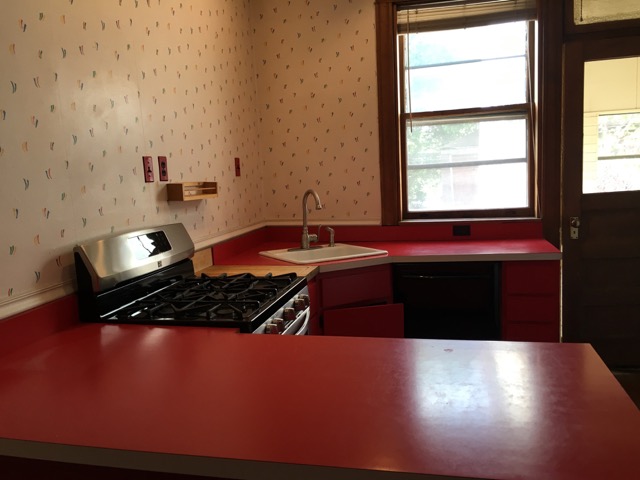
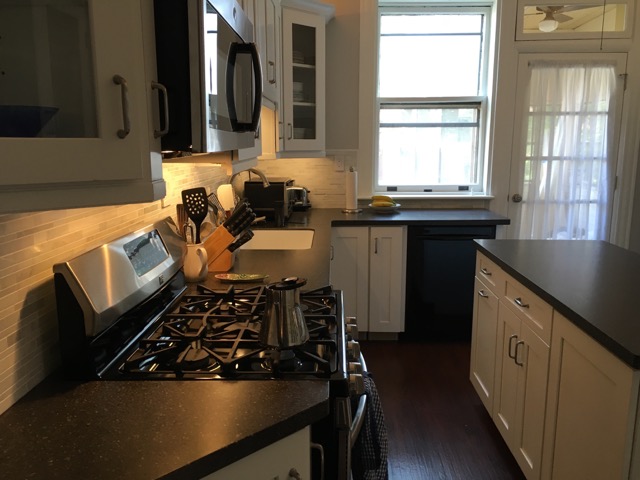
From the sink:
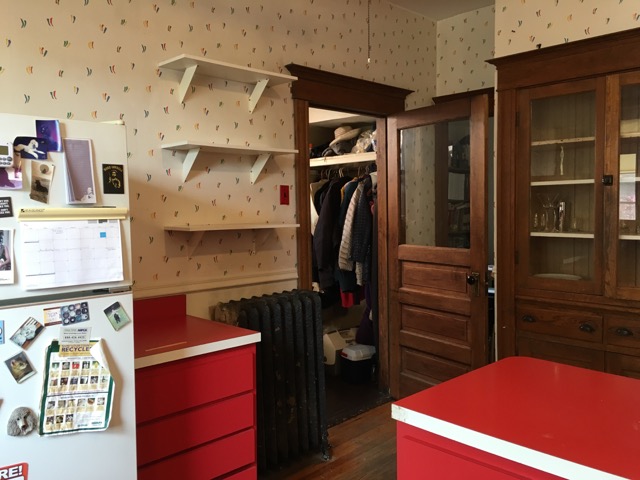
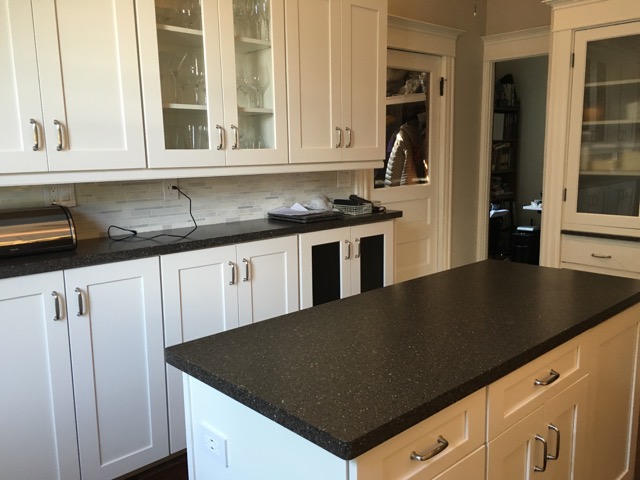
From the back door:
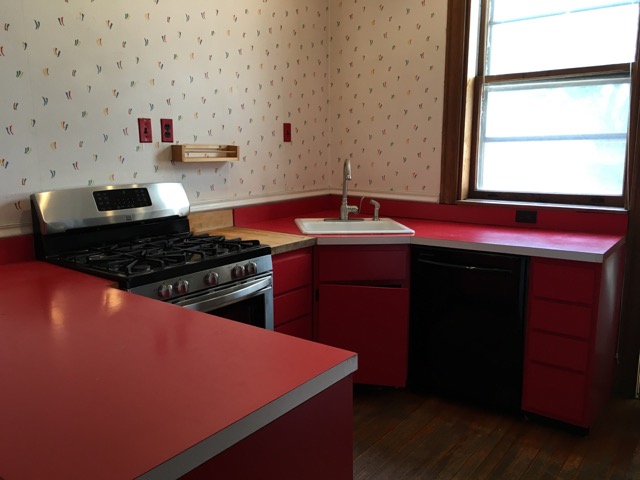
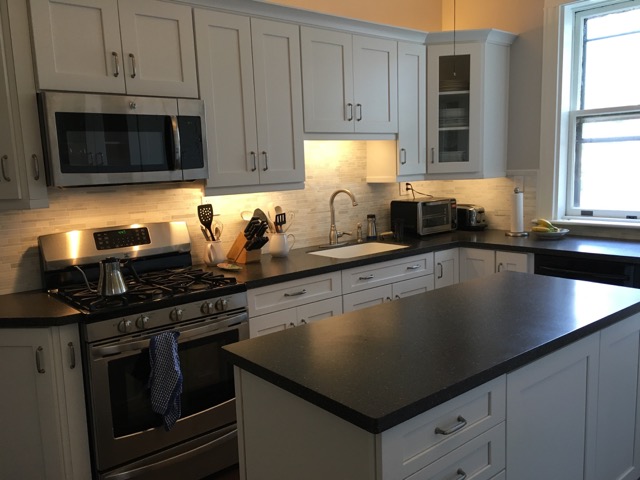
View of the built-in cabinet:
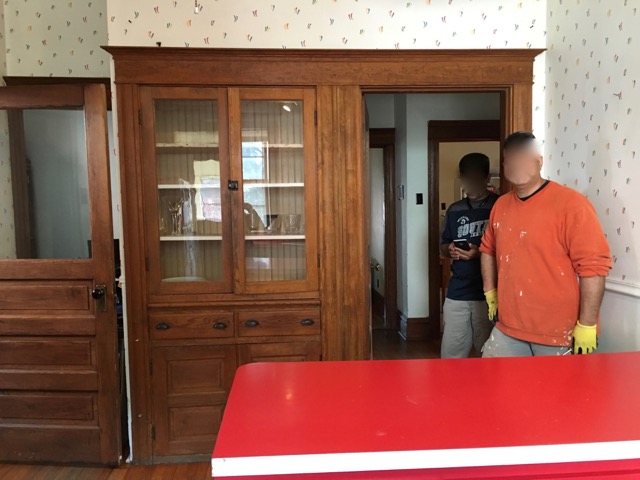
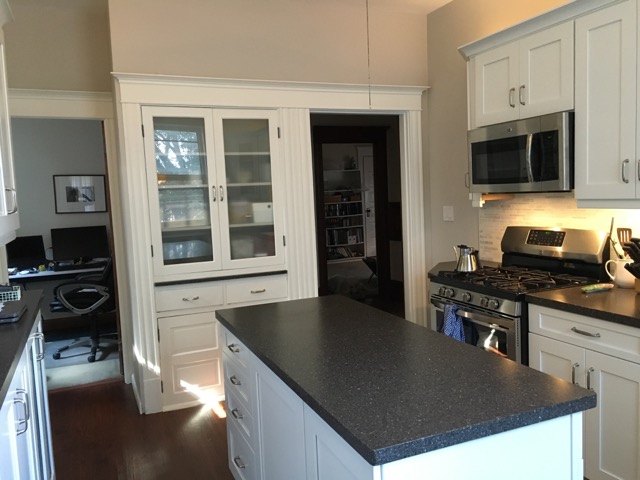
This last “after” shot shows that we sacrificed our pantry so that we could get the refrigerator out of the way. That was a stroke of genius on the part of the designer.
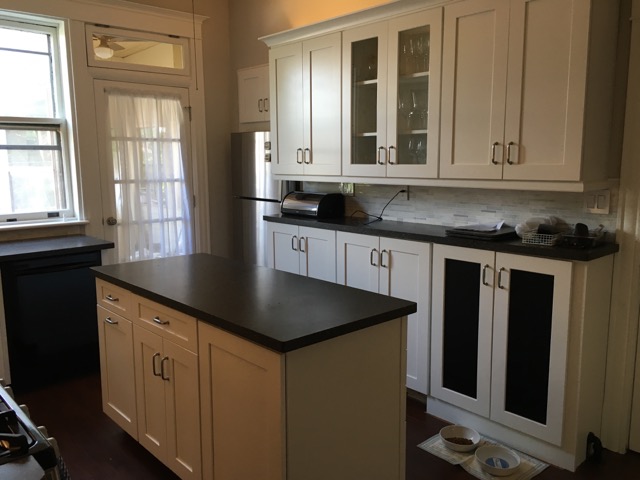
Nice change, huh? The kitchen is not only a lot more attractive, it’s a lot more functional since our storage space expanded many fold, despite our losing our pantry.
We used Home Depot to do this kitchen. The designer, Chris Burns, was exceedingly talented and such a joy to work with. The cabinets are American Woodmark Reading collection. The countertop is LG HI-MACS solid surface, with an integrated sink. We used Allure Ultra vinyl plank flooring. The backsplash is MS International Grecian White Interlocking. We kept our relatively new range and dishwasher but got a new stainless steel refrigerator (Whirlpool) and above-the-range microwave (GE), both purchased at Home Depot.
A big design challenge for Chris was the fact that this 10 × 13 kitchen has five doors in it, plus a built-in cabinet. (The pantry door was replaced by the refrigerator.) It also has a functioning radiator. The whole wall that used to house the refrigerator was designed around the radiator, which is now enclosed by cabinet doors with radiator grill in place of glass. (See the second and fifth after photos.)
We put upper cabinets above and below on the radiator wall. The bottom cabinets had to elevated a little to accommodate the radiator, which means there’s little vertical space on the counter between the cabinets. We only have room for a bread box and a place to stash our keys, which is just fine with me. The contents of the former pantry are now split between the cabinets on the radiator wall (which we call the bar) and the built-in cabinet.
Obviously, we painted all the woodwork white, which felt like a big deal but is such an amazing change. And we replaced the glass of our beloved built-in cabinet with frosted glass.
Getting rid of the peninsula and adding an island was a dream come true. This kitchen is now so functional and so easy to use, not to mention beautiful. It’s gone from a room we tolerated to one we love. It took some time, money and inconvenience, but it was worth every bit!
Renting, not buying, moving boxes
I recently coordinated a move for a client using recyclable plastic moving boxes from STL Rent A Box rather than purchasing cardboard boxes. It worked like a dream and I’ll definitely consider it for future moves.
STL Rent A Box provides heavy-duty plastic boxes with clamshell lid that are 27“L x 17“W x 12“H. The box is larger than a standard small moving box and longer but shallower than a medium. The boxes nest within each other when the flaps are open. They’re very sturdy. They stack when they’re closed.

For this particular move, I ordered 25 boxes. (I was guided by the handy packages STL Rent A box offers based on the number of rooms involved.) The boxes were delivered to my client’s home in two neat stacks on flat dollies. My team packed them and we supplemented them with a few cardboard boxes along with some clear plastic totes my client already had. (This was a local move.)
We marked the boxes with removable labels supplied by STL Rent A Box. The movers moved the boxes as usual into appropriate rooms in the new house. On unpack day, we unpacked the boxes and stacked them on the dollies. The day after we finished unpacking, STL Rent A Box came and picked up the empty boxes. No muss, no fuss.
Here’s what I liked about the experience:
- We saved money: The client paid just $99 for the boxes, including pick up and delivery.
- We saved time: We didn’t have to assemble and disassemble the boxes as we would have with cardboard boxes. I also didn’t have to take the time to purchase and pick up cardboard boxes.
- We saved effort: There were barely any empty boxes to worry about discarding when the move was over.
- We helped the environment: The boxes are reused (after sanitizing).
- We saved stress: Move day in this case happened to be a rainy day. It was nice not to have to worry about items getting wet or boxes falling apart.
STL Rent A Box owners Stacy and Todd Isermann couldn’t have been easier to work with. I called them on fairly short notice and they accommodated me seeming effortlessly. They were cheerful and professional. I’ll definitely suggest STL Rent A Box to my next moving client!
If you don’t live in St. Louis, have no fear. This isn’t a phenomenon limited to St. Louis A quick google search revealed this web site that lists other recyclable plastic moving box companies around the country. It’s worth noting that STL Rent A Box isn’t on that list so if your city isn’t mentioned it might be worth doing a little more digging.
I think this a terrific concept and I look forward to using them again!
Worth repeating: Need a reason to declutter? Do it for your pets
I wrote this post three years ago and I still talk about this kitty who so enjoyed his decluttered space. It came up last month, in fact. Making your animal’s life easier is another great reason to clear out a cluttered space.
Many of my clients are animal lovers. I’m an animal lover too. I even made my living as a pet writer before becoming an organizer. Perhaps I attract animal lovers.
I’ve never worked with animal hoarders (nor do I aspire to), but I’ve worked in severely cluttered homes that were also home to a few animals. I’m always amazed at how the animals maneuver around the clutter.
For some high-energy dogs or cats, a cluttered environment might feel like a fun playground or obstacle course. But I believe that most animals enjoy an orderly just like many humans do. They want wide open spaces in which to rest and play. They want to be able to get around easily.
This was brought home to me recently when my team worked on decluttering the crowded living space of a home occupied by one human and one young cat. As soon as we would clear a space (the top of the dining room table, for instance), he’d jump right up. Every time I turned around, it seemed the kitty had found a new spot in which to rest.
My favorite such moment was when I looked up and there he was in a china cabinet drawer that had just been emptied:

A little later, my heart sang when he started batting his toy around the newly clear living room floor.
If you’re looking for a reason to declutter your home, do it for your pets. I’m confident they’ll be happier and more comfortable.
My adventure with Project 333
Maybe you’ve heard of Project 333 It’s the brainchild of Courtney Carver of Be More with Less. She designed this challenge for herself in 2010 and encouraged her blog readers to follow suit. It swept the nation and is going strong. It dovetails nicely with the current interest in minimalism.
Essentially, Project 333 challenges participants to dress using only 33 items of clothing for 3 months. You can read the details at the link above, but here are the essentials.
What’s included in the 33 items:
- clothing
- outerwear
- jewelry
- accessories
- shoes
What’s not included in the 33 items:
- underwear
- sleepwear
- workout clothes/uniforms
- sentimental jewelry you wear every day (like your wedding ring)
You choose the 33 items you’ll wear for that season, then pack everything else up and store it. Courtney does not ask you to discard everything else, just pack it away. (Of course, you can discard items that don’t fit or you don’t love.)
Courtney Carver came to St. Louis in June as part of her Tiny Wardrobe Tour. I attended her talk and was inspired to give Project 333 a try. While I was listening to Courtney’s talk I decided that the workout clothes I wear when I lead organizing teams would not count in my 33 items, nor would the shorts and t-shirts I wear on my daily dog walks. (This was based on the answers I heard to the questions the audience asked.)
Sunday, July 3, was the big day. First, I jotted down the trips I was taking and the events I was planning to attend in the coming three months, so I could plan my wardrobe accordingly. Then I took a hard look at my hanging and folded clothes.
I brought some bins into the bedroom and started binning up the items that didn’t make the cut. I had already pared down my wardrobe over the last few years, but I still had plenty to store. In all, I ended up taking four 66 quart bins to the basement. One was for the items I thought I’d want to pull out first when the three months was over and it was time to select my fall collection of 33. The second bin was for clothes that came out of the closet and the third for clothes that came out of the dresser. (Minus the ones that went into the first bin of course.) The fourth bin was for shoes and accessories.
Selecting the 33 items wasn’t all that hard. The truth is that I wear the same things most of the time anyway. The whole process was definitely made easier by the fact that I didn’t have to choose to keep or discard clothing. It was just about a short-term commitment not to wear certain items.
Here’s what I ended up with in the main part of my closet:
- 2 pairs of dress pants
- 2 pairs of jeans (blue and white)
- 2 jackets
- 1 cardigan
- 5 long-sleeved blouses/shirts
- 6 short-sleeved shirts
- 1 tank
- 2 dresses (not pictured)
- 2 ponchos
- 1 shawl
- 1 down vest (for late September, just in case)
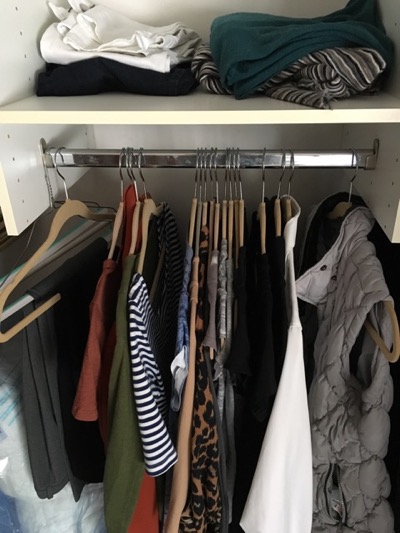
I selected three pairs of shoes: sneakers, sandals and dress shoes.
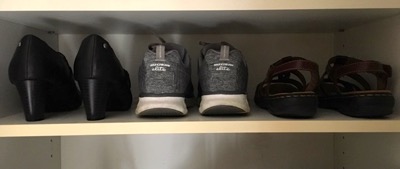
In addition, I selected three favorite pairs of earrings and one necklace:

And I included my favorite animal print scarf and black belt with faux tortoise buckle.
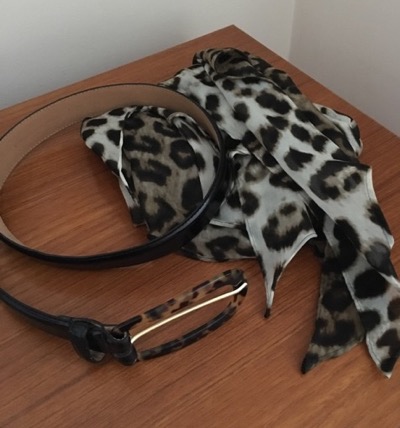
It’s been a month now, which has given me time to reflect on the benefits and pitfalls of the experiment. Overall, it’s made life much easier. Here’s how:
- It takes me no time at all to figure out what I’m going to wear.
- It’s really easy to find and put away clothes.
- I don’t worry about whether or not someone has seen me in the outfit because they probably have.
- I don’t have to give any advance thought to what I might wear. (And I can think about more important things!)
- I can do all my laundry in one load.
The down side? I’m starting to get a little sick of my options. And I worry a teeny tiny bit that an occasion will come up for which I don’t have something appropriate to wear. I’ll let you know at the end of September whether that happened.
By the time this three-month period is up, I will have gone to one conference and taken four other trips. I will have had first appointments with probably 20 clients. (Those first-appointment clothes come from the 33-item collection.) And, of course, I will have gone to social events. I’ll do all that wearing only things from my tiny wardrobe!
It’ll be interesting to see how the selection process goes when it’s time to pick out the 33 items for the fall/winter season. I suspect I’ll be anxious to make the switch.
This has been a fun experiment. Have you tried it?
We're all leaders
Recently, I attended the board retreat for the 2016-1027 board of directors of the St. Louis chapter of the National Association of Professional Organizers. (I serve on the board as Immediate Past President.) Our chapter president, Jennifer Stewart, kicked off the retreat by showing us this terrific video, Everyday Leadership.
In this video of his TedxToronto talk, Drew Dudley recounts the tale of how he made a huge difference in the life of an individual without knowing it. Or even remembering it. His message is that even our smallest actions can have an impact on others. That’s the essence of leadership. And we all do it.
It’s a profound message, with implications for our self-esteem, for our mindfulness, and for our kindness. Our actions matter. We don’t necessarily have to feel the need to change the world. But without even realizing it, we can change the world one individual at a time.
As Drew says, “It’s a simple idea, but I don’t think it’s a small one.” Watching this video is worth six minutes of your time. I urge you to go ahead and press Play. I think you’ll be glad you did.
Quick & easy checklist
Last month our standard poodle, Bix, had an issue with his eye that required ointment be applied three times daily. My schedule is variable so my husband and I shared responsibility for giving him the medicine. So I knew there had to be a way to keep track of whether it had been given.
Ointment is tricky because there’s no way to tell by looking at the container whether it’s been used. So I created a quick checklist to post in the bathroom. It was so easy and useful I thought I’d share it here.
Here’s a photo of it:
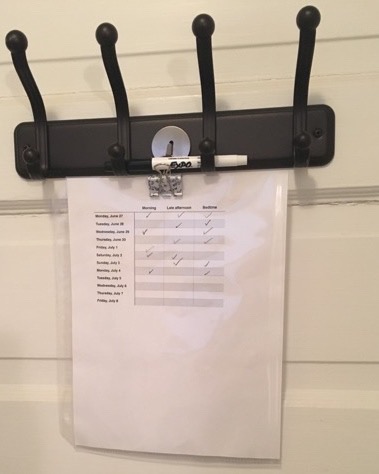
And here’s how I created it—it took maybe five minutes.
- I created a table in my word-processing program and printed it out.
- I put the sheet in a sheet protector.
- I clipped a binder clip to the top of the protector.
- I grabbed a magnetic hook and put in on the set of four metal towel hooks we have hanging on the bathroom door.
- I hooked the binder clip over the magnetic hook.
- I placed a dry-erase pen on the metal hooks.
The idea was that when Bix got his medicine, we’d check it off. It had the double advantage of helping us keep track of whether he’d received his medicine while also reminding us to give him his medicine.
As you an tell from the picture, even with this tool it was hard for us to keep up with applying the medicine three times a day. But I’m sure we did it more than we would have in the absence of the checklist. The good news was that he had a re-check and the vet reduced the frequency to an easier-to-implement once a day.
If we hadn’t had those metal hooks. this wouldn’t have been so easy-peasy. But I could have used Command hooks for the checklist and a pen.
There are higher tech ways to create checklists, but this was quick and (pretty) effective for us. Maybe it’ll help you too.
Worth repeating: Getting and staying on task
Effective task management is a moving target for me. I’ve come to accept that I need to switch things up in order to keep myself engaged and get stuff done. So I vary my systems according to my need and mood. This post, originally published May 22, 2013, describes a sort of emergency intervention I use when I just can’t get myself to get anything done.
For the last two days, I have had such a difficult staying focused and productive at my desk! My day yesterday was completely unstructured, which is sometimes a recipe for disaster for me. Without an appointment looming, it can be really hard for me to get started.
Today, I’m just trying to get a few hours of work in after my client appointment.
It’s not that I don’t know what to do: I have a four-item list I created this morning. (I usually create that the night before; that’s how unproductive I was yesterday.) A couple of those items will be very easy to accomplish. So why aren’t I starting?
I think I feel, for whatever reason, just really unfocused. Usually my to-do list is enough to focus me. Today, it’s going to take more. I’m pulling out the big guns: a timer + a reward.
One of the easy items on my task list is doing 15 minutes of Quickbooks entry. That’s right, just 15 minutes and I can check that off my list and feel accomplished. I often feel such resistance to even opening the Quickbooks program, though. It’s inexplicable. I actually rather enjoy accounting and my cash flow is positive, so it should feel good. But sometimes getting started on it is like pulling teeth. Thus the low threshold for success (15 minutes).
So that’s what I’m going to do. I’m going to spend 15 minutes on Quickbooks. And when I finish that, I’m going to give myself a reward: 15 minutes watching the mini-series The Pillars of the Earth which I have on DVD from the library. (I just finished reading the book again, so I’m going to enjoy it, I’m sure.)
I’ll layer 15 minutes of TV watching in after I finish each of the four items on my list.
Another good idea: I’m going to keep away from Facebook, Twitter and Pinterest. They’ve been such a distraction these last couple of days.
There. I have a plan. I’m starting to feel productive!
If you hit a productivity rough patch, you might try the one-two punch of a timed burst of activity coupled with a reward. It can be pretty powerful!
ETA: It worked! I got all the things on my list done, as well as some other stuff. That timer really got me going.
Links
- Getting to Good Enough podcast
- Are you interested in becoming a professional organizer?
- Shannon Wilkinson, life coach
- NAPO St. Louis
- Peace of Mind Spending
- Ravelry
- National Association of Productivity and Organizing Professionals
- Organize Your Family History
- Institute for Challenging Disorganization

